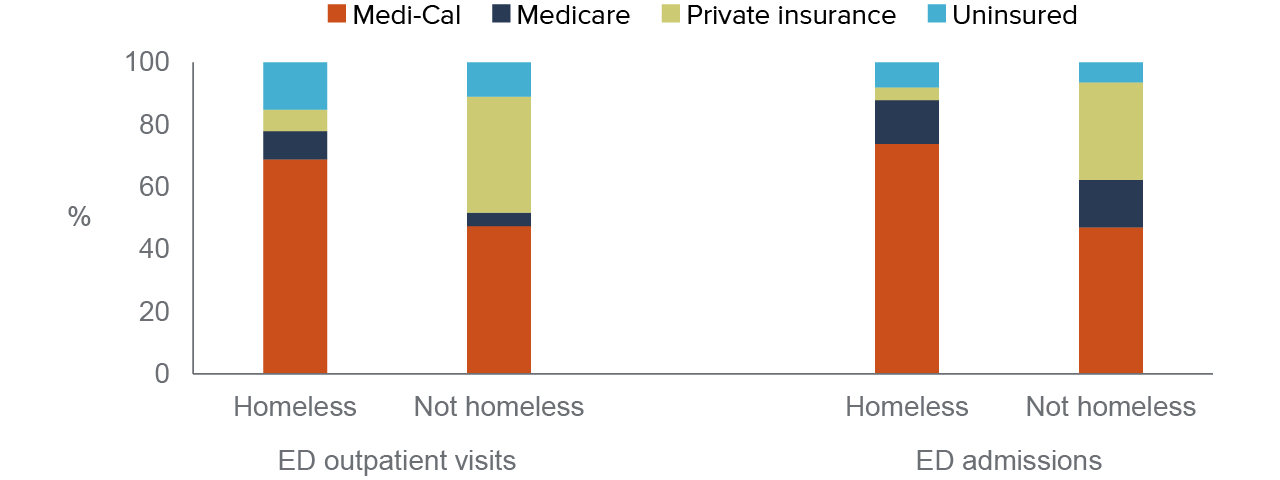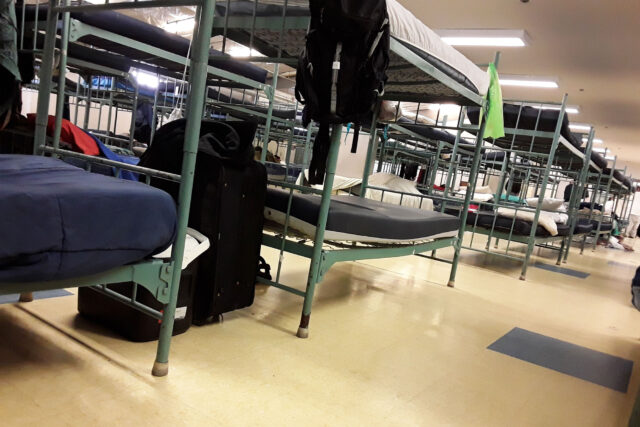Highlights
- California emergency departments (EDs) treated about 143,000 people experiencing homelessness in 2019, according to hospital discharge records. Almost half of homeless patients visited the ED four or more times in the year.
- Medi-Cal covered 70 percent of ED visits by homeless patients, underscoring the importance of the CalAIM program, which provides added Medi-Cal benefits, such as housing supports and case management.
- Linking discharge data with homeless assistance program data can offer insights into how people engage with EDs and homeless services across the state, and throughout the year, as well as help evaluate programs and public investments.
“We have folks who show up because they’re cold and hungry—we’re often the one safe place that they know they can go to 24 hours a day.”
As the only guaranteed source of health care open around the clock, emergency departments (EDs) are at the frontlines of serving Californians who are homeless. Comparing and linking the discharge data from EDs with details from homeless assistance programs and other state resources may help policymakers better understand and respond to the needs of California’s homeless population.
Medi-Cal covered most ED visits by patients identified as homeless

SOURCE: Authors’ analysis of HCAI hospital discharge data, 2019.
NOTE: Includes all ED visits by patients 18 to 64. Insurance coverage based on expected payment source for hospital visit
What do we know about California’s homeless population?
Homeless assistance programs conduct annual point-in-time counts—usually in January—to document local homeless populations. According to the annual counts, about 151,300 Californians were homeless on any given night in 2019. That number rose to 161,500 in 2020.
These programs also offer services ranging from emergency shelters to street outreach. During 2019, about 240,000 individuals received services at some point during the year.
What can hospital discharge data tell us about Californians who are homeless?
Discharge data can augment these other sources by offering a closer look throughout the year at where homeless Californians are accessing services, the health conditions people face, and treatments they receive in the ED. State law (SB 1152) expanded hospital reporting requirements for ED patients identified as homeless. Since July 2019, hospitals must keep a written record of what happens when staff discharge a homeless patient from the ED, including medications and food staff offered as well as referrals to assistance programs and outpatient health providers.
Patients identified as homeless made nearly 370,000 ED visits in 2019, or about 4 percent of all ED visits by adults under 65. At some hospitals, including large nonprofit and for-profit hospitals, homeless patients accounted for a quarter of all ED visits. Bay Area and Los Angeles hospitals reported heavy ED use among homeless patients, as did county-operated hospitals. Nearly every hospital in the state reported at least one ED visit where the patient was identified as homeless.
In interviews, patient registration staff described the difficulties of collecting basic information, as privacy concerns made screening for homelessness a challenge. Asking people about their housing—and homelessness in particular—was a sensitive issue.
“For the patients that are disclosing that they’re at a shelter or they’re carrying a lot of bags, it’s almost a little easier to identify that they’re homeless. It’s really the ones that… are a little bit more stable. They might even be staying in an RV and maybe still working… trying to capture it is hard because homelessness is really broad when you really look at the actual definition of it.”
Medical staff shared that people who present at EDs with clear behavioral health issues may be more apt to be recorded as homeless, which is consistent with the data analysis. Schizophrenia (8%) and alcohol-related disorders (7%) were the most common primary diagnoses, and some chronic conditions like hypertension were diagnosed more often with homeless patients than other low-income patients.
How can hospital discharge data help address homelessness?
California has invested billions to address homelessness, with the 2022–23 state budget adding $3.4 billion over three years to continue services. By linking hospital ED data with data from other programs, organizations would gain a powerful tool to identify who is at risk of or experiencing homelessness—such as those with acute medical and mental health needs—and intervene quickly.
CalAIM—the Medi-Cal add-on that includes intensive case management and community services for homeless Californians—is one example where linked data could prove valuable. Medi-Cal covered 70 percent of ED visits by homeless patients; connecting data could mean connecting patients sooner with CalAIM supports or examining who may not be getting connected.
Several large counties have already integrated data between systems such as county mental health services, jails, and hospital EDs. Integrating data can give researchers and policymakers a stronger understanding of program outcomes, and help direct funding to services that may benefit most.



